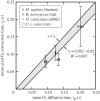Cerebral oxygenation and optimal vascular brain organization
- PMID: 25972435
- PMCID: PMC4590512
- DOI: 10.1098/rsif.2015.0245
Cerebral oxygenation and optimal vascular brain organization
Abstract
The cerebral vascular network has evolved in such a way so as to minimize transport time and energy expenditure. This is accomplished by a subtle combination of the optimal arrangement of arteries, arterioles and capillaries and the transport mechanisms of convection and diffusion. Elucidating the interaction between cerebral vascular architectonics and the latter physical mechanisms can catalyse progress in treating cerebral pathologies such as stroke, brain tumours, dementia and targeted drug delivery. Here, we show that brain microvascular organization is predicated on commensurate intracapillary oxygen convection and parenchymal diffusion times. Cross-species grey matter results for the rat, cat, rabbit and human reveal very good correlation between the cerebral capillary and tissue mean axial oxygen convective and diffusion time intervals. These findings agree with the constructal principle.
Keywords: diffusion and convection time; mammalian vascular architecture; optimal; oxygen.
© 2015 The Author(s) Published by the Royal Society. All rights reserved.
Figures


Similar articles
-
Uncertainty quantification of parenchymal tracer distribution using random diffusion and convective velocity fields.Fluids Barriers CNS. 2019 Sep 30;16(1):32. doi: 10.1186/s12987-019-0152-7. Fluids Barriers CNS. 2019. PMID: 31564250 Free PMC article.
-
Increases in microvascular perfusion and tissue oxygenation via pulsed electromagnetic fields in the healthy rat brain.J Neurosurg. 2015 May;122(5):1239-47. doi: 10.3171/2014.8.JNS132083. Epub 2014 Oct 24. J Neurosurg. 2015. PMID: 25343187 Free PMC article.
-
The effects of capillary transit time heterogeneity (CTH) on brain oxygenation.J Cereb Blood Flow Metab. 2015 May;35(5):806-17. doi: 10.1038/jcbfm.2014.254. Epub 2015 Feb 11. J Cereb Blood Flow Metab. 2015. PMID: 25669911 Free PMC article.
-
Oxygen supply to contracting skeletal muscle at the microcirculatory level: diffusion vs. convection.Acta Physiol Scand. 2000 Apr;168(4):593-602. doi: 10.1046/j.1365-201x.2000.00710.x. Acta Physiol Scand. 2000. PMID: 10759595 Review.
-
Dynamics of intestinal oxygenation: interactions between oxygen supply and uptake.Am J Physiol. 1982 Aug;243(2):G91-6. doi: 10.1152/ajpgi.1982.243.2.G91. Am J Physiol. 1982. PMID: 7051852 Review.
Cited by
-
On the Validation of a Multiple-Network Poroelastic Model Using Arterial Spin Labeling MRI Data.Front Comput Neurosci. 2019 Sep 3;13:60. doi: 10.3389/fncom.2019.00060. eCollection 2019. Front Comput Neurosci. 2019. PMID: 31551742 Free PMC article.
-
The Ageing Brain: Investigating the Role of Age in Changes to the Human Cerebral Microvasculature With an in silico Model.Front Aging Neurosci. 2021 Aug 5;13:632521. doi: 10.3389/fnagi.2021.632521. eCollection 2021. Front Aging Neurosci. 2021. PMID: 34421568 Free PMC article.
-
Lifelong exposure to high-altitude hypoxia in humans is associated with improved redox homeostasis and structural-functional adaptations of the neurovascular unit.J Physiol. 2023 Mar;601(6):1095-1120. doi: 10.1113/JP283362. Epub 2023 Feb 23. J Physiol. 2023. PMID: 36633375 Free PMC article.
-
RETRACTED ARTICLE: The quantum physiology of oxygen; from electrons to the evolution of redox signaling in the human brain.Bioelectron Med. 2018 Oct 17;4:13. doi: 10.1186/s42234-018-0014-7. eCollection 2018. Bioelectron Med. 2018. Retraction in: Bioelectron Med. 2019 Jun 20;5:7. doi: 10.1186/s42234-019-0026-y. PMID: 32232089 Free PMC article. Retracted. Review.
-
Longitudinal optical coherence tomography imaging of tissue repair and microvasculature regeneration and function after targeted cerebral ischemia.J Biomed Opt. 2020 Apr;25(4):1-15. doi: 10.1117/1.JBO.25.4.046002. J Biomed Opt. 2020. PMID: 32285652 Free PMC article.
References
-
- Siesjö BK. 1978. Brain energy metabolism. Bath, UK: John Wiley.
-
- Young T. 1809. On the functions of the heart and arteries. Phil. Trans. R. Soc. 99, 1–31. (10.1098/rstl.1809.0001). - DOI
Publication types
MeSH terms
Substances
LinkOut - more resources
Full Text Sources
Other Literature Sources
Miscellaneous

